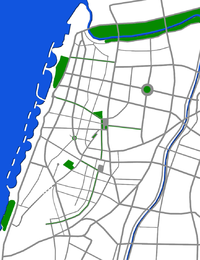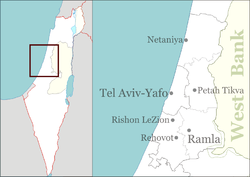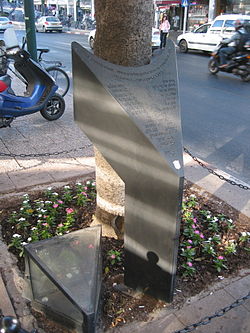- Dizengoff Street bus bombing
-
Dizengoff Street bus bombing
Location Dizengoff Street, Tel Aviv, Israel Coordinates 32°4′44.31″N 34°46′26.26″E / 32.078975°N 34.7739611°E Date October 19, 1994
9:00 am (GMT+2)Attack type Suicide attack Death(s) 22 civilians (+ 1 suicide bomber) Injured 50 Perpetrator(s) One suicide bomber (Saleh Abdel Rahim al-Souwi). Hamas claimed responsibility. The Dizengoff Street bus bombing was a Hamas suicide attack on a passenger bus driving down Dizengoff Street in Tel Aviv in 1994. At that time, it was the deadliest suicide bombing in Israeli history, and the first successful attack in Tel Aviv.[1] Twenty-two civilians were killed and 50 were injured. [2]The attack was planned by Hamas chief Yahya Ayyash, on the eve of the signing of the Israel-Jordan Treaty of Peace.
Contents
Background
Yahya Ayyash was disappointed that the previous attack he orchestrated, the Hadera central station suicide bombing, had killed "only" six Israelis. The bomb used in that attack had been small and made of acetone peroxide, a relatively weak explosive. For the attack on bus five, Ayyash constructed a bomb using an Egyptian land mine packed with twenty kilograms of military-strength TNT, surrounded by nails and screws.[3] TNT is not readily available in the Palestinian territories, but Hamas had managed to acquire some by smuggling it in or purchasing it from Israeli organized crime. The device "was one of the best ever built by Ayyash."[4]
Qalqilya resident Saleh Abdel Rahim al-Souwi was selected for the attack. Al-Souwi joined Hamas after his older brother Hasin was killed in 1989, in a shootout with Israeli forces. Al-Souwi was wanted by the Israeli Shabak, but was not considered a high priority.[5] The day before the attack, al-Souwi taped a statement saying "It is good to die as a martyr for Allah" and "Sages end up in paradise".[6]
The attack
Muatab Mukadi, a member of Ayyash's Samaria battalion (of the Izz ad-Din al-Qassam Brigades), drove al-Souwi to one of the bus's first stops. al-Souwi chose an aisle seat on the left side of the bus, and placed the bomb (stored in a brown bag) at his feet.
At approximately 9:00 AM, as the bus was slowing down for a stop 100 metres north of Dizengoff Square, al-Souwi detonated the bomb killing 21 Israelis and one Dutch national. The powerful explosion lifted the bus off its chassis and the heat melted the fiberglass bus frame. Limbs were projected like missiles into the seating area of nearby restaurants. [7]
Following the explosion, a crowd of demonstrators descended on the bomb site chanting "Death to the Arabs".[7] "Police arrested scores of Arab suspects in and around the blast area, though most of them were detained to save them from the crowd's anger."[7]
Fatalities
- Haviv Tishbi, 54, Tel Aviv
- Moshe Gardinger, 83, Tel Aviv
- Pnina Rapaport, 74, Tel Aviv
- Galit Rosen, 23, Holon
- Zippora Ariel, 64, Tel Aviv
- David Lida, 74, Tel Aviv
- Puah Yedgar, 56, Givatayim
- Dalia Ashkenazi, 62, Tel Aviv
- Esther Sharon, 21, Lod
- Ofra Ben-Naim, 33, Lod
- Tamar Karlibach-Sapir, 24, Moshav Zafaria
- Shira Meroz-Kot, 20, Kibbutz Beit Hashita
- Miriam Adaf, 54, Sderot
- Anat Rosen, 21, Ra'anana
- Salah Ovadia, 52, Holon
- Eliahu Wasserman, 66, Bat Yam
- Alexandra Sapirstein, 55, Holon
- Dr. Pierre Atlas, 56, Kiryat Ono
- Ella Volkov, 21, Safed
- Ayelet Langer-Alkobi, 26, Kibbutz Yiron
- Kochava Biton, 59, Tel Aviv
- Reinier Verbiest, 25, Netherlands. [8]
Aftermath
At the time of the attack, it was the deadliest in Israeli history. However, subsequent bombings have been even more devastating, among them the Jaffa Road bus bombings, the Passover suicide bombing, and the Shmuel Hanavi bus bombing.
Yitzhak Rabin, then Israel's Prime Minister, who was in the United Kingdom on a state visit, immediately returned to Israel. Ayyash's name and pictures of the demolished bus were featured in newspapers around the world.
Israeli police quickly identified al-Souwi as the perpetrator. The day after the bombing, with his identify confirmed using DNA, al-Souwi's family threw a neighborhood party celebrating his "martyrdom." That afternoon, the Israel Security Agency (ISA) destroyed the house, after giving the family one hour to remove their possessions.[9]
References
Bibliography
- Katz, Samuel (2002). The Hunt for the Engineer. Lyons Press. ISBN 1585747491.
Prominent terrorist attacks against Israeli targets in the history of the Arab–Israeli conflict – the 1990s 1990 Assassination of Meir Kahane (November 5)1992 Night of the Pitchforks (February 14) – Attack on the Israeli embassy in Buenos Aires (March 17) – Murder of Helena Rapp (May 24)1993 Mehola Junction bombing (April 16) – Murder of Yaron Chen (August 5)1994 Afula Bus suicide bombing (April 6) – Hadera central station suicide bombing (April 13) – Attack on the Israeli embassy in London (July 26) – Kidnapping of Nachshon Wachsman (October 14) – Dizengoff Street bus bombing (October 19) – Netzarim Junction bicycle bombing (November 11) – Afula ax attack (November 30)1995 Beit Lid massacre (January 22) – Kfar Darom bus attack (April 9) – Ramat Gan bus 20 bombing (July 24) – Jerusalem bus 26 bombing (August 21)1996 First Jerusalem bus 18 suicide bombing (February 25) ‡ – Second Jerusalem bus 18 suicide bombing (March 3) – Dizengoff Center suicide bombing (March 4)1997 Island of Peace massacre (March 13) – Café Apropo bombing (March 21) – Mahane Yehuda Market Bombings (July 30) – Ben Yehuda Street Bombing (September 4)‡ indicates the terrorist attack which caused the greatest amount of Israeli casualties during the 1990s
Full list of Palestinian suicide attacks • Full list of Lebanese rocket attacks on Israel
1980s
 2000sCategories:
2000sCategories:- 1994 in Israel
- History of Tel Aviv
- Palestinian suicide bomber attacks against buses
- Terrorist incidents in 1994
- Terrorism in Tel Aviv
Wikimedia Foundation. 2010.



